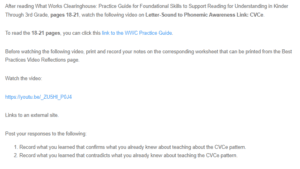Best Practices Video Reflection – Letter-Sound to Phonemic Awareness Link: CVCe
Before watching the video, I knew that word-building activities are essential in understanding letter-sound relationships and linking them with phonemic awareness. Word-building exercises help students acknowledge each letter’s significance in a word. Changes in any word’s phoneme alter its spelling, pronunciation, and meaning (Foorman et al., 2016). The video confirms this knowledge on forming CVCe words. Based on the knowledge of forming CVC words, such as bit, the students can form a CVCe word using the silent-e rule to form the word bite. In the word-building activity, students add, delete, and substitute phonemes in a word to form different words. For instance, in the word ‘fin,’ one can add a silent-e at the end to form ‘fine’ or delete /e/ in the form ‘fin.’ Also, the /n/ in ‘fine’ can be substituted with /v/ to form ‘five.’ The video also confirms that the letter tiles are essential in word-building activities. Educators provide their students with letter tiles and Elkonin sound boxes to help them manipulate the phonemes to form different words (REL Program, 2016). Our assignment help will hone your writing prowess for papers that will awe your professors.
The video provides no contradictory information from earlier knowledge about teaching the CVCe patterns. However, all the illustrations provided affirm prior knowledge of how students form new words by addition, substituting, and deleting phonemes. The video also emphasizes the importance of educators offering feedback to the students in the word-building activities. Educators’ guidance in the word-building activity makes it more effective and poses fewer challenges to students internalizing the skills and knowledge rendered. Letter-sound knowledge increases students’ phonemic awareness skills, which is vital in developing their reading and writing skills. Also, letter-sound knowledge improves students’ spelling and pronunciation ability. Hence, teachers should mentor their students to increase their proficiency.
References
Foorman, B., Beyler, N., Borradaile, K., Coyne, M., Denton, C. A., Dimino, J., & Wissel, S. (2016). Foundational skills to support reading for understanding in kindergarten through 3rd grade. Educator’s Practice Guide. NCEE 2016-4008. What Works Clearinghouse.
REL Program. (2016). Video 19: Letter–sound to phonemic awareness link: CVCe [Video]. YouTube. https://www.youtube.com/watch?v=_ZU5Hl_P0J4
ORDER A PLAGIARISM-FREE PAPER HERE
We’ll write everything from scratch
Question

Letter-Sound to Phonemic Awareness Link CVCe
After reading What Works Clearinghouse: Practice Guide for Foundational Skills to Support Reading for Understanding in Kinder Through 3rd Grade, pages 18-21, watch the following video on Letter-Sound to Phonemic Awareness Link: CVCe.
To read the 18-21 pages, you can click this link to the WWC Practice Guide.
Before watching the following video, print and record your notes on the corresponding worksheet that can be printed from the Best Practices Video Reflections page.
Watch the video:
Links to an external site.
Post your responses to the following:
- Record what you learned that confirms what you already knew about teaching about the CVCe pattern.
- Record what you learned that contradicts what you already knew about teaching the CVCe pattern.

